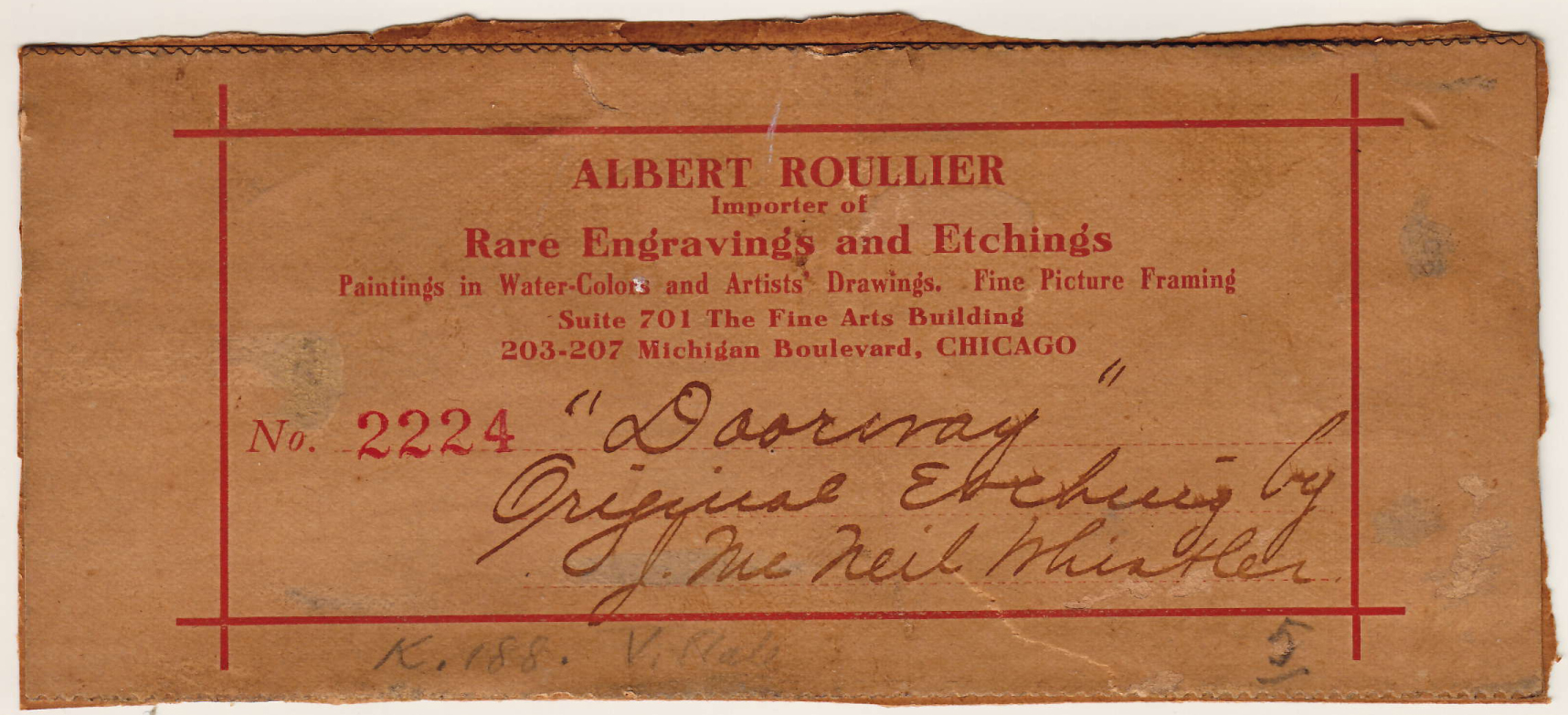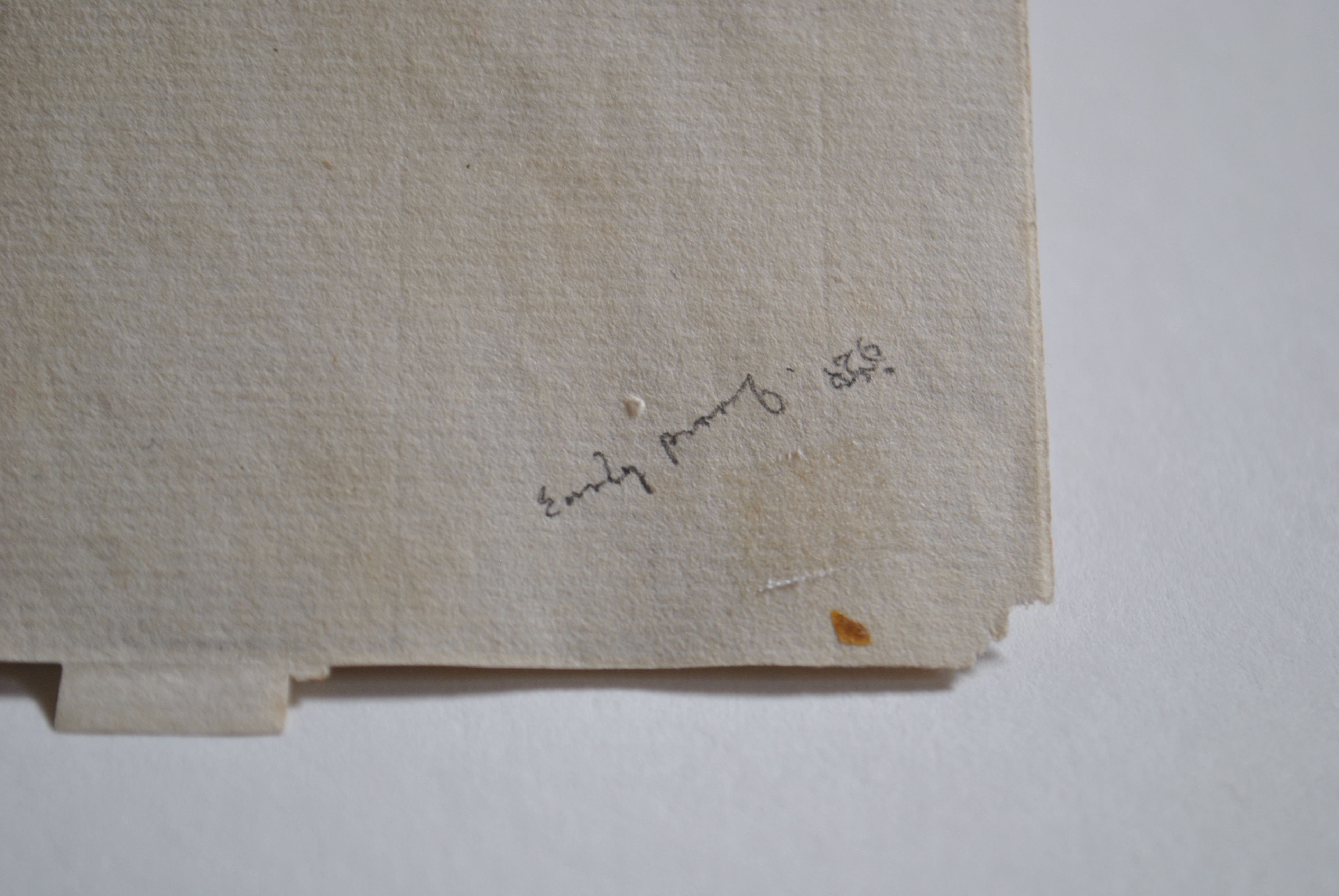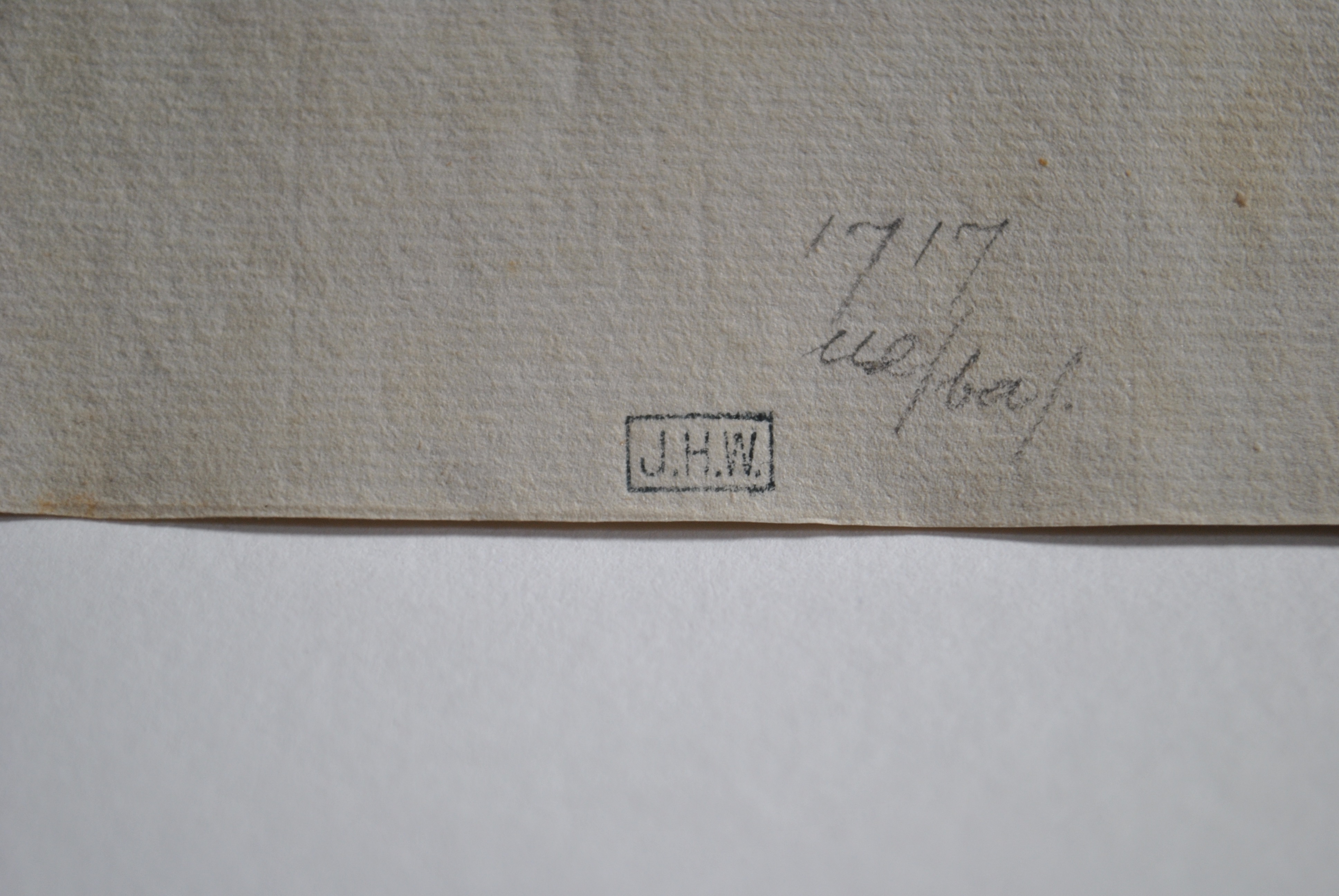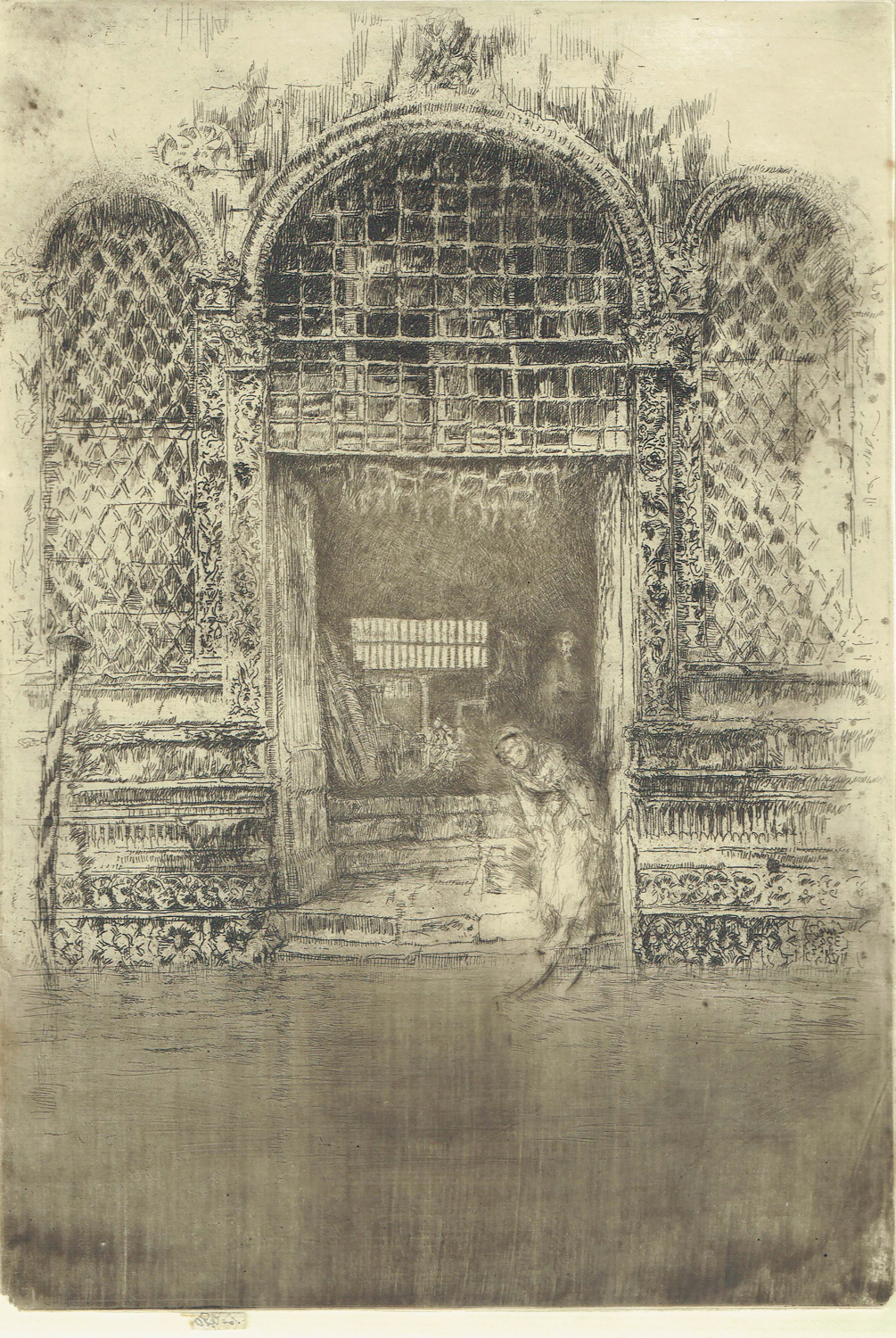
|
|
The Doorway
Kennedy 188.5, Mansfield
185, Glasgow 193.10
etching,
with drypoint, roulette,
open bite, and carefully wiped tonal monotyping in the foreground and upper
corners, 1879, on medium-fine laid
paper with the "hunting horn in shield"
watermark (which is characteristic of early impressions), trimmed to
the platemark, signed on the tab in pencil (twice!), annotated "early proof"
and again signed on the verso by the artist in pencil, a superb and
exceedingly rare proof impression of this exceptional print, the Vth state of VII according to
Kennedy, the 10th state of
20 according to Glasgow (see the discussion below),with old hinges on the upper sheet
edge, verso,
lower corners somewhat frayed, and two short parallel nicks in the left margin, otherwise
in remarkably fine
condition, having never been framed or exposed

Provenance:
the prestigious John
Henry Wrenn collection (with his wetstamp verso),* and acquired from Albert Roullier, Chicago, prior to
1910, as attested by the label affixed to the original mount, right**
P. 295 x
203 mm., S. 299 (with tab) x 203 mm.

|
James McNeill
Whistler first traveled to Venice in 1879-80, fell in love with the
city, and stayed for fourteen months. He completed about fifty
etchings, seeking to capture Venice’s time-worn beauty in a new
way. In 1880 he wrote: "I have learned to know a Venice in
Venice that
others never seem to have perceived . . . " His etchings most
often depict
the quiet streets and backwaters beyond the Grand Canal, avoiding the
longstanding tradition of vedute,
the majestic views of the city’s main sites. As one scholar
noted, Whistler sought to capture "the essence of the crumbling city:
its texture, its light, its distinctive enclosed calli and piazze, and
its unique ‘floating’ quality." Whistler even carried his pastels
and etching materials with him as he explored the city, drawing from
life, sur le motif.
Venice, a Series of Twelve Etchings
(the 'First Venice Set') comprised twelve etchings. It was
comissioned by the Fine Art Society, London in 1879, and first
exhibited and published in 1880, though Whistler spent the next twenty
years working on it, as he refused to entrust the work to a commercial
printer; part of the edition was still unfinished at the time of his
death in 1903. (See the Glasgow website entry at
https://etchings.arts.gla.ac.uk/catalogue/sets_texts/?eid=venice1)
The Doorway in
particular had a rather turbulent printing history as it is one of
Whistler's most elaborate undertakings in the series (the Glasgow WEP lists
twenty states of rework and develops the process in detail:
https://etchings.arts.gla.ac.uk/catalogue/search/ts_display/index.php?catno=K188&rs=&q=doorway&xml=pri).
Its printing was also unfinished at the time of his death. 
Whistler
expressly annotated the present impression as an "Early proof" (N.B.
its authenticity has been acknowledged by Margaret MacDonald, right),
and it is worthwhile here to examine how it fits into this history. We
however need some background in order to make headway...
Edward
Guthrie Kennedy was one of the most important fine print dealers in the
United States at the turn of the 19th-20th centuries, as well as an
avid collector, and connoisseur; he was also a good friend of
Whistler's, as is attested by their rich correspondence, now held in
the New York Public Library (see
https://archives.nypl.org/mss/1631). In short, he was then the
most capable person to undertake a study of Whistler's printmaking and
his 6-volume catalogue raisonné of Whistler's etchings, published in
1910, is still most authoritative.
It should firstly be noted that the present impression
served E. G. Kennedy as his reference proof for the state V entry and was accordingly
reproduced by collotype therein.****
He clearly identified its provenance and described it thus:
V. There is a heavy dry-point line on top of the girl's head; others,
short, light, and slanting, are at her left, and four, slightly curved
and heavy, are in the water just below her feet. The background
appears to have been rubbed down and worked over with fine lines,
while the woman recedes more into it and is slighter. J. H. Wrenn
These features merit some discussion and should be compard with the Glasgow entry.
The present impression, now listed on the Glasgow website, is identified as their state 10:
see
https://etchings.arts.gla.ac.uk/catalogue/etchings/etching/?filename=K1880501&catno=K188&etchlist=y
As Whistler
pulled a few proofs of each state for himself, the Glasgow WEP
references another impression for their state 10, which is now held at
the Bibliothèque Nationale de France
(See https://etchings.arts.gla.ac.uk/catalogue/etchings/etching/?filename=K1880709)***
The BNF impression appears to have been somewhat rubbed and damaged, whcih complicated comparison.
The Glasgow description of this state 10 is somewhat different, while revising certain of Kennedy's features:
Slight
alterations to the girl on the step include the shape of her head and
delineation of her facial features, a dark line across the top of her
head, reduced shading on the bodice of her dress; new shading is added
to right of her skirt, reducing its fullness; four curving diagonal
drypoint lines appear on the water below the girl's feet; new drypoint
shading around the woman in the doorway reduces the width of her
shoulders and torso.
This is, in any case, one of
Whistler's most famous etchings from the Venice series and the present impression is of paramount importance..

* John
Henry Wrenn (cf. his stamp on the present impression, Lugt 1475, right) was an early collector
of Whistler's etchings in Chicago, and a large part of his
collection was bequeathed to the Art Institute of Chicago in
1924.
(See https://etchings.arts.gla.ac.uk/catalogue/biog/?nid=WrenJH; in their descriptions of the prints included thereon, the Glasgow
website mentions him forty times!)
** Cf. the entry concerning Albert Roullier on the Glasgow website: etchings.arts.gla.ac.uk/catalogue/biog/?nid=Roull1
This deterioration of the sheet may well be original,
as it is already evident in Kennedy''s collotype illustration in 1910!
*** See https://gallica.bnf.fr/ark:/12148/btv1b8559443m?rk=21459;2
****
The original Kenedy catalogue is available online at
https://archive.org/details/texts?and%5B%5D=the+etched+work+of+whistler&sin=
See Kennedy's illustration
of our impression at
https://archive.org/details/gri_33125012338386/page/n11/mode/2up?view=theater
In addition to its
provenance, it may be easily identified by virture of the careful
monotyped wiping patterns,
as well as the two lower
frayed corners, an original feature of the proof rather than a later
deterioration.





